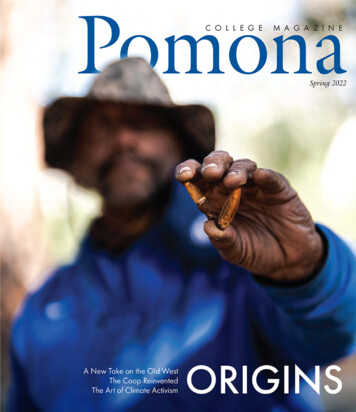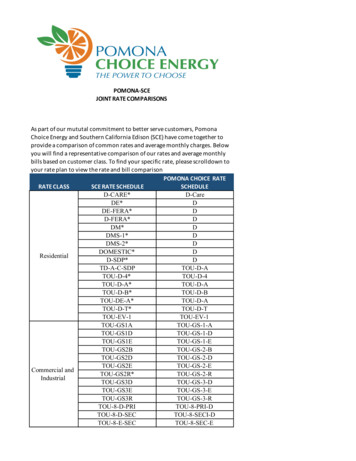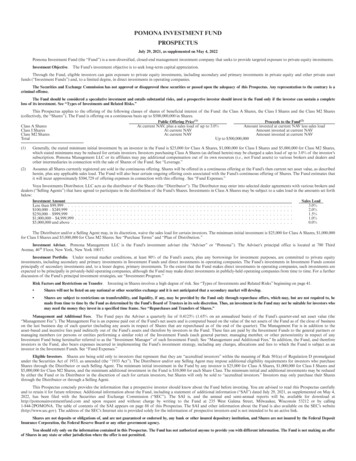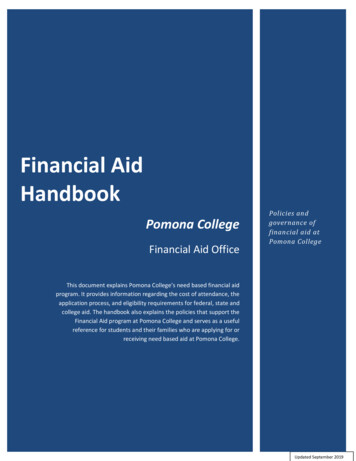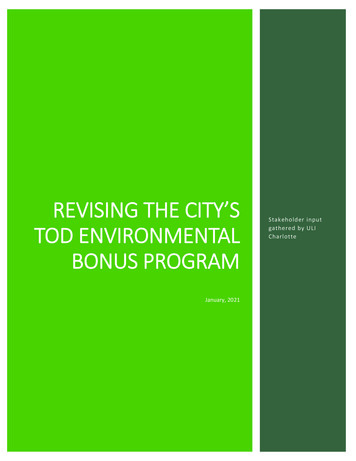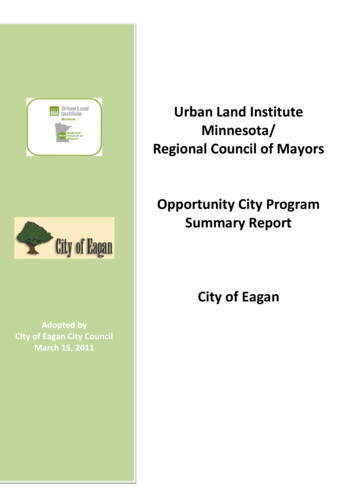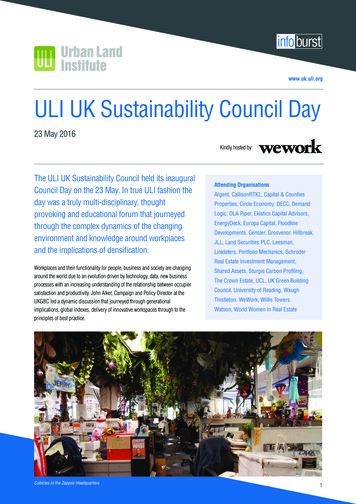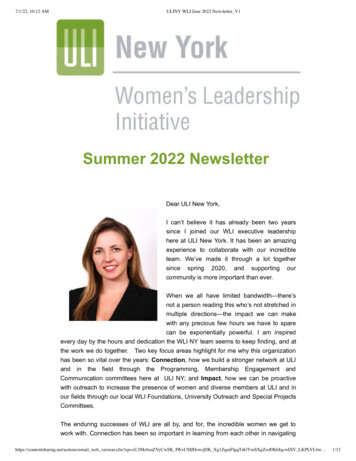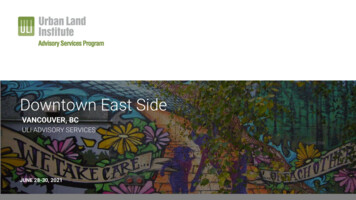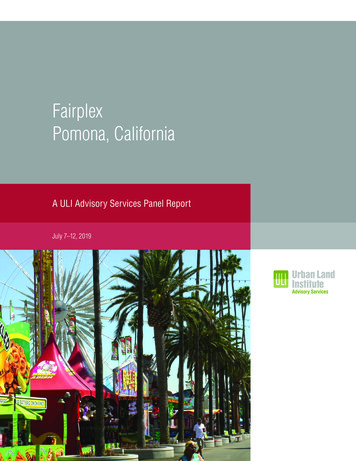
Transcription
FairplexPomona, CaliforniaA ULI Advisory Services Panel ReportJuly 7–12, 2019Advisory Services
Fairplex, Pomona, CaliforniaReimagining Fairplex and the L.A. County FairA ULI Advisory Services Panel ReportJuly 7–12, 2019Urban Land Institute2001 L Street, NWSuite 200Washington, DC 20036-4948uli.org
About the Urban Land InstituteTHE URBAN LAND INSTITUTE is a global, member-drivenorganization comprising more than 46,000 real estate andurban development professionals dedicated to advancingthe Institute’s mission of providing leadership in the responsibleuse of land and in creating and sustaining thriving communitiesworldwide.ULI’s interdisciplinary membership represents all aspectsof the industry, including developers, property owners,investors, architects, urban planners, public officials, realestate brokers, appraisers, attorneys, engineers, financiers,and academics. Established in 1936, the Institute has apresence in the Americas, Europe, and the Asia Pacific region,with members in 81 countries.Peer-to-peer learning is achieved through the knowledgeshared by members at thousands of convenings each yearthat reinforce ULI’s position as a global authority on land useand real estate. In 2019 alone, more than 2,400 events wereheld in about 330 cities around the world. Drawing on thework of its members, the Institute recognizes and shares bestpractices in urban design and development for the benefit ofcommunities around the globe.More information is available at uli.org. Follow ULI onTwitter, Facebook, LinkedIn, and Instagram.ULI’s extraordinary impact on land use decision-makingis based on its members’ sharing expertise on a variety offactors affecting the built environment, including urbanization,demographic and population changes, new economic drivers,technology advancements, and environmental concerns.COVER PHOTO: Anna Aran/Flickr 2020 by the Urban Land Institute2001 L Street, NW Suite 200 Washington, DC 20036-4948All rights reserved. Reproduction or use of the whole or any part of the contents ofthis publication without written permission of the copyright holder is prohibited.
About ULI Advisory ServicesTHE GOAL OF THE ULI ADVISORY SERVICES program isto bring the finest expertise in the real estate field to bearon complex land use planning and development projects,programs, and policies.Since 1947, this program has assembled well over 700ULI-member teams to help sponsors find creative, practicalsolutions for issues such as downtown redevelopment, landmanagement strategies, evaluation of development potential,growth management, community revitalization, brownfieldredevelopment, military base reuse, provision of low-cost andaffordable housing, and asset management strategies, amongother matters. A wide variety of public, private, and nonprofitorganizations have contracted for ULI’s advisory services.Each panel team is composed of highly qualified professionalswho volunteer their time to ULI. They are chosen for theirknowledge of the panel topic and are screened to ensure theirobjectivity. ULI’s interdisciplinary panel teams provide a holisticlook at development problems. A respected ULI member whohas previous panel experience chairs each panel.The agenda for a five-day panel assignment is intensive. Itincludes an in-depth briefing day composed of a tour of thesite and meetings with sponsor representatives, a day ofhour-long interviews of typically 50 to 100 key communityrepresentatives, and two days of formulating recommendations.Long nights of discussion precede the panel’s conclusions. Onthe final day on site, the panel makes an oral presentation ofits findings and conclusions to the sponsor. A written report isprepared and published.Because the sponsoring entities are responsible for significantpreparation before the panel’s visit, including sending extensivebriefing materials to each member and arranging for the panelto meet with key local community members and stakeholdersin the project under consideration, participants in ULI’s five-daypanel assignments are able to make accurate assessmentsof a sponsor’s issues and to provide recommendations in acompressed amount of time.A major strength of the program is ULI’s unique ability to drawon the knowledge and expertise of its members, includingland developers and owners, public officials, academics,representatives of financial institutions, transportation planners,and others. In fulfillment of the mission of the Urban LandInstitute, this Advisory Services panel report is intended toprovide objective advice that will promote the responsible use ofland to enhance the environment.ULI Program StaffPaul BernardExecutive Vice President, Advisory ServicesThomas W. EitlerSenior Vice President, Advisory ServicesDeborah Kerson BilekVice President, Advisory ServicesPaul AngeloneDirector, Advisory ServicesLauren CallaghanDirector, Advisory ServicesJacqueline CanalesDirector, Advisory ServicesGeorgia GemplerSenior Associate, Advisory ServicesJames A. MulliganSenior EditorJoanne Platt, Publications Professionals LLCManuscript EditorBrandon WeilArt DirectorDeanna Pineda, Muse Advertising DesignGraphic DesignerCraig ChapmanSenior Director, Publishing Operations
ULIAcknowledgmentsOn behalf of the Urban Land Institute, the panel would like tothank Fairplex and its partners for sponsoring this importantexercise evaluating and reviewing how the Fairplex site canbecome an engine for economic growth and a year-rounddestination. The panel extends a special thanks to Fairplex’sstaff, board, and association members; L.A. County Fair vendors;public officials of the cities of Pomona and La Verne; and otherstakeholders, including ULI trustee Wayne Ratkovich.In addition, thanks go to the many other organizations andindividuals who shared their perspectives, experiences, andinsights with the panel throughout the week.This Hollywood sign, providing a backdrop for a portrait of ULI panelmembers, is part of the 2019 L.A. County Fair “Pop Culture” theme.
Contents223326ULI Panel andProject StaffAssignment and Summary of KeyRecommendations8Connectivity of Land Uses andTransportationImplementationBranding and Core Business30Conclusion3213Summary of Recommendations19About the PanelFramework PlanEnvironmental and FinancialSustainability35
ULI Panel and Project StaffPanel ChairGlenda HoodPresidentHood Partners LLCOrlando, FloridaPanel MembersParag AgrawalCommunity Development DirectorCity of MiltonMilton, GeorgiaNat BottigheimerDirectorState Programs and New JerseyRegional Plan AssociationPrinceton, New JerseyAri ErlichmanChief Development OfficerLe Grand RéservoirParis, FranceJonathan GelberVice PresidentBleakly Advisory GroupAtlanta, Georgia2A ULI Advisory Services Panel ReportMichael MaurerPrincipalPerkins EastmanChicago, IllinoisStephanie PankiewiczPartnerLandDesignAlexandria, VirginiaULI Project StaffDeborah Kerson BilekVice President, Advisory ServicesGrace HillManager, Meetings and Events,Business OperationsGeorgia GemplerSenior Associate, Advisory ServicesPatricia KirkFreelance Journalist
THEREALTHUMMERAssignment and Summary of Key RecommendationsUNDER NEW MANAGEMENT, THE NEARLY 100-YEAR-OLD FAIRPLEX is poised for a transformation to meetchanging demographics and future market challenges. This 501(c)(5) nonprofit organization has a public/privatepartnership with Los Angeles County.The site, which includes 487 acres mostly owned by LosAngeles County, is home to the L.A. County Fair, which hostsabout 1.2 million fair-goers and holds more than 500 eventsannually that bring more than 3 million visitors to Fairplex.as a variety of exhibition buildings and horse barns that couldbe repurposed.Located within the cities of Pomona and La Verne, California,the expansive Fairplex site is among the largest fairgroundsnationally. It has significant on-site real estate assets andinfrastructure, including Quonset hut–style buildings; museums;a Sheraton hotel and conference center; an on-site farm thatserves the hotel’s farm-to-table restaurant and catering service;a forested area; a child development center; train exhibits;occupational training facilities for high school students; sportsfields; and a grandstand and other entertainment venues; as wellThe Urban Land Institute was invited to reimagine Fairplex’spotential as an economic engine and year-round destination andto identify the following opportunities:The Assignment Create a plan for the future that honors the past Improve land use, sustainability, and use of existing assets Create economic impact Improve the flow of visitors from future mass transitresources and within the Fairplex complexFairplex, Pomona, California, July 7–12, 20193
FAIRPLEX (2017)Fairplex includes nearly 500 acres and is bounded by Arrow Highway to the north, Fairplex Drive to the west, West McKinley Avenue to the south, andNorth White Avenue to the east. Enhance programming and the visitor experience with newlandscaping and experiential opportunitiesGenerate additional revenueCreate mutually beneficial partnerships with communitybusinesses and organizationsConnect with and engage the local communityGoals for the ULI panel included improving the site’s visualinterest and connectivity with surrounding neighborhoods;creating a cultural hub and year-round destination that engagesand improves the community; developing a strong, regionaleconomic engine; and ensuring the highest and best use ofland, existing assets, infrastructure, and resources.Key TakeawaysThe ULI panel spent five days touring the site and surroundingcommunity and interviewing more than 80 Fairplex4A ULI Advisory Services Panel ReportPATRICIA KIRK/ULI Built in the 1930s, Quonset hut–style buildings are used for exhibitions duringthe fair and host various events throughout the year. The expansive interiorsmake them suitable for a variety of uses, and the exceptional ceiling heightoffers an opportunity to create a second-story loft.stakeholders, who included community members; publicofficials; representatives from community businessesand organizations; Fairplex’s staff, board of directors, and
GEORGIA GEMPLER/ULIFAIRPLEX STRATEGIC PLANThe Learning Centers at Fairplex, a 501(c)(3) nonprofit organization, operatesthe Fairplex Child Development Center, which serves 250 community childrenages 12 weeks through kindergarten. It also operates the Career and TechnicalEducation Center, which offers occupational training programs for highschool students.association members; members of the Learning Centers andChild Development Center boards; and vendors.In 2018, Fairplex completed a strategic plan to update,revise, and refresh its vision and goals, including makingFairplex a model community partner, economic engine,and presenter of unique experiences. Guiding principles toattain the desired future include providing public benefit,improving the guest experience, developing partnerships,committing to both financial and environmentalsustainability, and creating a uniquely Southern Californiadestination that celebrates the community.This plan—which aims to reinforce Fairplex’s originalvision and put it into a contemporary context—addresseswhom Fairplex serves, why change is needed, and whatFairplex wants to become. Fairplex enlisted the assistanceof ULI to develop a detailed vision for Fairplex’s future anda road map to achieve it.Source: Fairplex Board of Directors, “Fairplex StrategicPlan,” June 4, 2018, ns/strategic-plan-2018.pdf?sfvrsn 2.Stakeholder interviews revealed a variety of community andstaff visions for Fairplex: Creating a live/work/play environment with greenways andopen spaceInstalling technology upgrades to attract youngergenerations Expanding farm and job training programs Expanding the Fairplex Child Development Center Creating a uniquely Southern California destination Developing attainable, multigenerational housing Reorienting the site to improve access to the Gold Linelight rail, which is scheduled for completion in 2025Comments from stakeholders on Fairplex’s operations weremostly positive, but they cited past struggles and criticisms,and recent efforts to rebuild trust and engage more people toimprove community relationships and involve the community inplanning efforts.In 2022, Fairplex will celebrate its 100th anniversary.Historically, Fairplex has prioritized the recognition of theregion’s agricultural roots. Although this identity is rootedin a universal sense of nostalgia for many, interviews withstakeholders found that some people in the community feel leftout or excluded from Fairplex, and they believe the site shouldbe a gathering place where everyone feels welcome year-round.Fairplex was founded not only to host the L.A. County Fair,but also to provide holistic support for the local communityfinancially, through commerce and agriculture; socially, asa convener and community gathering place; and artistically,by offering members of the community space to share theircreations and passions.Fairplex has already demonstrated the desire to involvestakeholders through the strategic planning process and shouldcontinue to do so. The ULI panel, however, emphasizes theimportance of engaging all community groups in formulatingideas going forward, as community support is critical to anyproject to ensure support and the project’s success. The panel’skey takeaways are summarized below.Solidify identity. Interviews with stakeholders revealedambiguity about Fairplex’s identity. The ULI panel believesFairplex’s identity and core businesses need clearer articulationand suggests evaluating those businesses to identifyopportunities for generating the best returns for Fairplex and itsinvestment partners.To remain relevant and representative of future land usechanges, the panel also suggests spearheading a rebrandinginitiative to update the organization’s name. Involving thecommunity and all stakeholders in this process will be criticalto ensuring success of the rebranding effort. New brandFairplex, Pomona, California, July 7–12, 20195
DEBORAH KERSON BILEK/ULIDEBORAH KERSON BILEK/ULIHosted by the Automobile Club of Southern California in November, the NationalHot Rod Association (NHRA) Championship Drag Race is among the 500events held at Fairplex annually. This facility, which seats 40,000 spectators,is one of the few drag strips in America operated directly by the NHRA.Fairplex has discontinued equine events. The ULI panel suggests repurposinghorse barns for entrepreneurial uses and exhibition halls.development can assist in better reflecting the true identity ofthe organization, while boosting marketing opportunities andigniting new revenue-producing activities.its origins as an opportunity for agricultural exchange, and itwill need to evolve to remain relevant to today’s consumers andthe “experience economy.” This vision for Fairplex and the fairaligns with Fairplex’s new strategic plan.Another concern of the panel is a seeming conflict orpolarization between “what Fairplex has been” and “what itcan be.” Some stakeholders indicated a resistance to change.In addition, many on-site functions have outlived theirrelevance, and there appears to be little appetite for innovativeor significant change to reflect modern needs or changingdemographics.Fairplex has a window of opportunity to realign thinking aboutenhancing experiences and renewing the physical environmentfor the world of tomorrow. This effort could work hand in handwith a rebranding exercise to create renewed interest and civicownership.Pursue an imaginative and sustainable framework plan.As part of the paradigm shift of Fairplex as a year-rounddestination, Fairplex should open up the campus to thecommunity and make it more accessible. Panelists recommendcreating a northern gateway to connect Fairplex to the city ofLa Verne’s proposed light-rail station, and connecting it to apedestrian-oriented promenade, or “green artery,” that wouldserve as Fairplex’s main street and would traverse the entireproperty. The green artery would wind through internal Fairplexneighborhoods, creating a sense of internal connectivity, andwould terminate at a new Fairplex village destination on the eastside of the campus.Embrace a paradigm shift: Fairplex as a year-rounddestination that also operates the L.A. County Fair. Fairplexcan become more responsive to the shifting retail economy andcommunity needs by leveraging its impressive land assets tobecome a year-round destination for the local community andothers within the Inland Empire. By working to create a unifiedsense of place in all parts of the property and opening forcontinuous use, Fairplex can deepen its community connectionsand expand possibilities for revenue generation. Achieving thisvision will require adopting a land use planning mind-set inaddition to Fairplex’s event-planning expertise.Incorporate the history of the fair experience into all aspectsof design, use, and programming. Part of solidifying identityinvolves addressing history. Fairplex should incorporate itsstory into future projects, including signage that educatesvisitors about Fairplex’s history and illustrative artwork thatshowcases Fairplex’s role in the community—from its originsas home to the L.A. County Fair to its use during World WarII as an assembly center for Japanese internment camps.“The Fair” is also suggested as a new theme for the proposedFairplex Children’s Museum.The panel also recommends that Fairplex continue to operatethe L.A. County Fair. Fairplex is uniquely positioned to develop theL.A. County Fair into an experience that is enhanced by theproposed year-round land uses. The fair has moved away fromEmphasize the role of the community. The community iscritical to the success of Fairplex’s transformation to a yearround destination. Engaging the community must be includedin any and all rebranding and planning processes to guaranteesupport for future projects.6A ULI Advisory Services Panel Report
Fairplex should also become a model of environmentalsustainability—particularly during the fair. The panel offersthree specific recommendations: Create on-site renewable energy production and storagefacilitiesForm mutually beneficial partnerships with local energycompanies and clean-tech businessesImplement best practices for water stewardship, includingreplacing parking lot surfaces with permeable material,retaining and recycling stormwater and graywater on site,creating bioswales, daylighting streams underneath thecampus, and creating a stormwater retention lake thatdoubles as a water featureEnsure connectivity of land uses and transportation. Parkinglots comprise about 300 of Fairplex’s nearly 500 acres of land,because the majority of visitors now access the campus viapersonal vehicles. Over time, other modes of transportation—including light rail, ride sharing, and autonomous vehicles—areexpected to reduce parking requirements, freeing up land forother uses. Ride sharing has already begun to alleviate the needfor parking. The panel recommends investing in infrastructurethat encourages using alternative transportation modes: Increased ride-sharing dropoff/pickup facilitiesDirect, safe, and convenient access from rail stations toFairplex points of entryTram service from the new La Verne Fairplex gateway tothe carnival during the fairTemporary, dedicated bus lanes at the main gate duringthe fair to provide greater passenger convenienceSupport implementation concepts that promote modelpartnerships and sustainability. Fairplex’s success infulfilling its mission as a community benefit and achievingfinancial sustainability will depend on its relationships withoutside organizations. The panel recommends that Fairplexmanagement look for opportunities to form mutually beneficialpartnerships with businesses, local government agencies,educational and health care institutions, and nonprofits thatenhance Fairplex’s visibility and support in the community.Evaluate internal and external governance. To respond todiverse community needs now and in the future, Fairplex shouldconsider reorganizing its governance structure to align with thegoals and objectives in the strategic plan, and should includeexperts capable of guiding redevelopment efforts. The shift infocus to include land use planning and development calls fora corresponding shift in governance. The panel recommendsthat Fairplex’s internal governance structure be evaluated andreconfigured to best meet these future needs, challenges,and opportunities related to the distinct businesses under theorganization’s umbrella.In addition, a strong partnership between Los Angeles Countyand Fairplex will be required to realize the full vision of a newframework plan with year-round use and applicability. The newvision for Fairplex will have countywide economic implications.Given that a significant number of Fairplex’s operations takeplace on county-owned land, and Fairplex’s lease with thecounty ends in 2043 with two renewal options, a strongpartnership with Los Angeles County is critical. To ensurethat connectivity of land uses and long-term development arepossible and sustainable, Fairplex must leverage its partnershipwith Los Angeles County to achieve a unified vision.Create functional, flexible phasing. It will take severaldecades or more to fully realize Fairplex’s future vision. Thepanel approached its recommendations as an exercise that isrooted in the best practices of urban planning and thereforerecommends beginning by identifying short-, medium-,and longer-term priorities and opportunities. Start thetransformation process with highly visible, impactful, andwell-publicized projects that require minimal funding and can becompleted within one to two years. All initiatives going forwardshould focus on building visibility, audience, and density ofconsumers and visitors to support existing Fairplex operationsand to create demand for subsequent phases and initiatives.Fairplex, Pomona, California, July 7–12, 20197
DEBORAH KERSON BILEK/ULIConnectivity of Land Uses and TransportationEXTERNAL CONNECTIVITY IS A CRUCIAL CONCEPT, and challenge, for Fairplex’s vision. Physical barriers blockpathways, reinforcing negative ideas of exclusion and inaccessibility. Physical connections and accessible pathwayscould reinforce positive ideas and relationships among Fairplex visitors, neighbors, partners, and members of thebroader community.Improving external connectivity may also increase resourcesfor reinvestment in Fairplex facilities and programs and sharingwith public partners. Specifically, better external connections,such as improved links to regional transit, support transformingparking lots—an underused capital asset—to productive landthat consistently generates a high level of financial return forFairplex and its stakeholders throughout the year.Better external connectivity could also attract new visitors andeconomic activity to Fairplex year-round, generating additionalrevenue and reducing dependence on fair-related income asthe primary source of funding for public programs, such as jobtraining and the Child Development Center.8A ULI Advisory Services Panel ReportExternal connectivity involves various modes of transportation,including personal and shared vehicles, rail and bus transit,regional trail networks, and access across and along WhiteAvenue.Historically, personal vehicles have been the primary mode oftransportation connecting visitors and partners to Fairplex. Thesurrounding network of roadways was engineered to supportautomobile traffic volumes during periods of peak demand,including the annual fair.Currently, Fairplex’s parking lots can accommodate about35,000 vehicles. Entrance gates and surface streets aroundFairplex are designed to accommodate the arrival of vehicles
from all directions, and internal barriers and external fencesseparate paid parking areas and paid event areas from dropoff/pickup zones. Fairplex has partnered with the Pomona PoliceDepartment to manage traffic flows and limit neighborhoodimpacts.Continued total reliance on personal vehicles for access toFairplex, however, limits the availability of land for uses thatgenerate a consistently high level of revenue and providegreater community benefit than is now possible. It alsoperpetuates transportation practices inconsistent with theorganization’s commitment to sustainability.Rail TransitTwo major regional transportation investment programs willprovide Fairplex with an opportunity to rebalance on-site landuse by strengthening external orientation and connectivity. Theyare the planned Gold Line Foothill extension, which is scheduledfor completion in 2025; and the separate MetroLink Lone Hillto White Double Track Project, which offers the prospect ofadditional transit access for Fairplex visitors. Gold Line light-railArtist conception of La Verne Gold Line Station.METRO GOLD LINE FOOTHILL EXTENSION CONSTRUCTION AUTHORITYThe panel, therefore, recommends investing in additionalmodes of external access over time to increase management’sflexibility to repurpose land assets for revenue generation andcommunity benefit purposes.Investing in facilities that support access to Fairplex by sharedvehicles is strategically beneficial in reducing the amount ofsurface parking required and in increasing land available forproductive reuse.BLUE MCRIGHTDEBORAH KERSON BILEK/ULIThe nearly 300 acres of parking lots are a significant source of income forFairplex during the L.A. County Fair. Over time, other modes of transportationare expected to replace personal automobile access, allowing land nowoccupied by parking lots to be converted to residential and commercial usesthat provide consistent revenue year-round.Fairplex staff members report that travel to Fairplex byshared-ride vehicles, such as Lyft and Uber, is increasing,with a noticeable impact on parking revenue and availability.The increase in shared-vehicle access is correlated withdeclining vehicle ownership by young adults, increased use ofride-sharing apps by adults of various ages, and responsiblebehavior of young adults related to driving under the influence.The La Verne Gold Line station will provide access to Fairplex for visitors located all along the Gold Line, which will create a new Fairplex gateway.Fairplex, Pomona, California, July 7–12, 20199
CITY OF LA VERNEBRIAN ZIMMERMANAn illustration of development standards and guidelines on the northernparcel of Fairplex in the city of La Verne. These standards are laid out in theOld Town La Verne Specific Plan.Plans by the regional rail system MetroLink for the Lone Hill to White DoubleTrack Project will improve visitor access to Fairplex.service will provide riders direct access to Fairplex activities,and double-tracking the MetroLink commuter-rail corridor willprovide riders more frequent seasonal access to Fairplex.To take advantage of the new Gold Line and improvedMetroLink service, Fairplex will need to provide direct, safe, andconvenient access for passengers from rail stations to Fairplexpoints of entry. The access challenge for the future Gold Line isto connect the La Verne rail station across Arrow Highway to anew Fairplex gateway.An above-grade connection across Arrow Highway is alsopossible by developing a gradually rising, elevated plaza fromthe train station to connect directly to Fairplex. Panelistssuggest that it may be possible to redirect funding allocatedfor construction of a Gold Line parking garage to the plazaconnection across Arrow Highway in exchange for surfaceparking at Fairplex. This trade would allow automobile accessto the Gold Line, while providing priority access for pedestriansand greatly increasing Fairplex’s external connectivity to GoldLine passengers, La Verne residents, and bus riders who alsotraverse Arrow Highway.METRO GOLD LINE FOOTHILL EXTENSION CONSTRUCTION AUTHORITYOptions for connecting Fairplex to the rail station acrossArrow Highway at grade include controlled, amenitizedpedestrian crossings at E and F streets; or given largevolumes of pedestrians at fair time, across the entire lengthof the block. Fairplex’s proposed internal promenade, thegreen artery, could also be designed to connect with anat-grade crossing on Arrow Highway at the intersection withWhite Avenue, which would connect with the shared-use pathplanned adjacent to the Gold Line tracks between the La Vernerail station and North White Avenue.February 2020 diagram of the proposed location of a parking structure. Funding for the parking structure could possibly be used to construct an above-gradewalkway from the rail station to Fairplex in exchange for parking at Fairplex.10A ULI Advisory Services Panel Report
A preliminary plan for a transit-oriented development (TOD)on a northern Fairplex parcel that is within the city of La Verneemphasizes vehicle access to Arrow Highway. Although itrecognizes the need for pedestrian pathways within the TODand toward the Gold Line rail station, the plan does not providedetailed concepts for safe, convenient, direct pedestrianconnections from the Fairplex site to the Gold Line rail platformacross Arrow Highway.Alternatively, maps of transit travel times using General TransitFeed Specification tools and the number of Fairplex visitorswithin the transit geographic area could be quantified. Dataavailable from vendors such as streetlight data can provideextremely granular detail on vehicle-trip origins to Fairplex,including to different Fairplex parking lots by time of day, day ofweek, and route taken.Fairplex staff members may need to engage with transitagencies to eliminate route delays, costs, or discomforts thatcould discourage Fairplex visitors from using rail transit inplace of personal vehicles. Collaboration on the design of the LaVerne rail station, service, schedules, travel costs, and so forthcould help make transit a competitive option relative to personalvehi
Urban Land Institute 2001 L Street, NW Suite 200 Washington, DC 20036-4948 uli.org . This Hollywood sign, providing a backdrop for a portrait of ULI panel . Fairplex includes nearly 500 acres and is bounded by Arrow Highway to the north, Fairplex Drive to the west, West McKinley Avenue to the south, and
